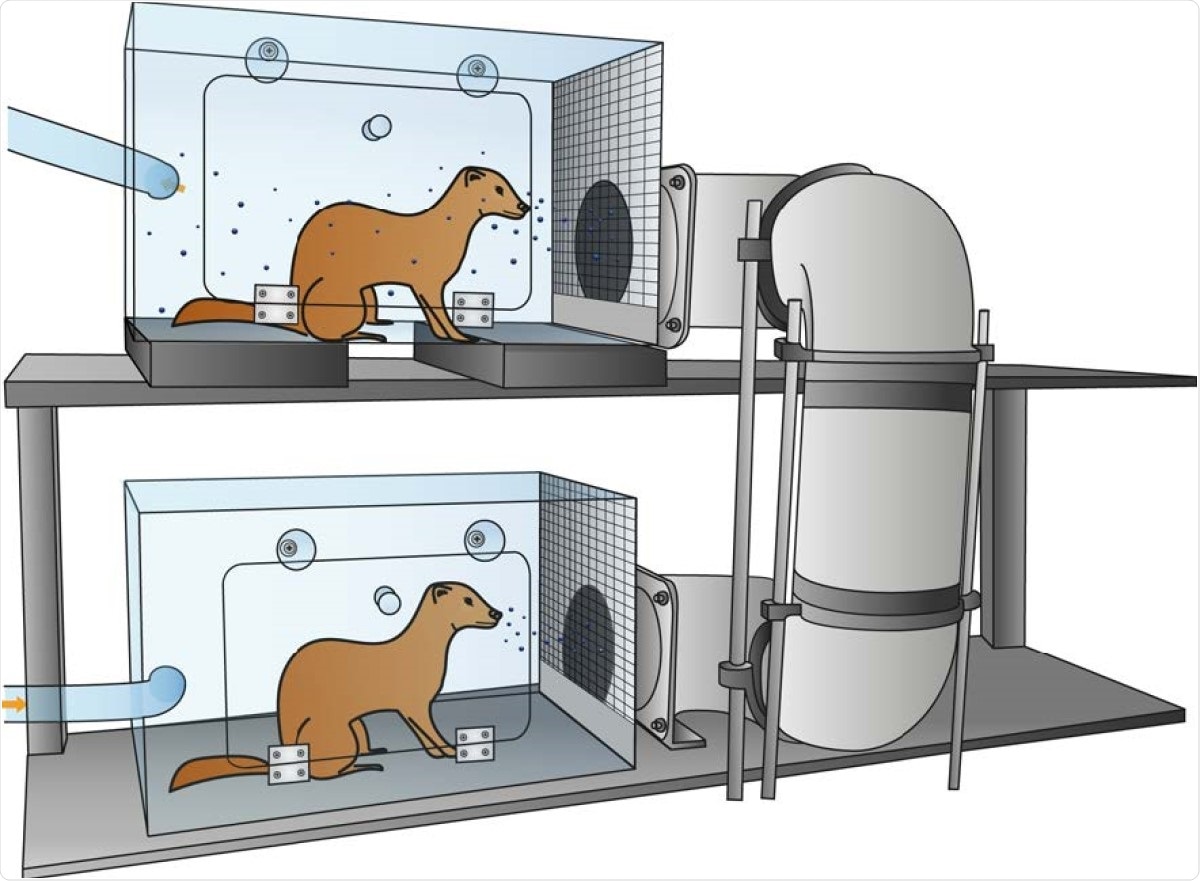A team of researchers led by Sander Herfst from Erasmus University Medical Center in The Netherlands suggests severe acute respiratory syndrome coronavirus 2 (SARS-CoV-2) could spread through the air at a one-meter distance and cause infection in a new ferret model study.
They also found the SARS-CoV-2 can be dispersed through ferret fur, indicating a brand-new mode of transmission.

Schematic representation of the set-up to assess transmission over >1 m distance. An inoculated donor ferret is housed in the bottom cage and the next day, an indirect recipient ferret is added to the top cage. The cages are connected through a hard duct system consisting of four 90° turns. The system is built of several horizontal and vertical 15 cm wide PVC pipes that allow upward airflow from the donor to the indirect recipient animal. The average length of the duct system is 118 cm with the shortest and longest length 73 and 163 cm, respectively. A steel grid is placed over the inlet and outlet of the duct system. The bottom five cm of the grid was closed to prevent spill-over of food, feces, and other large particles into the tube system. Orange arrows indicate the direction of airflow (100 L/min). Set-ups were placed in class III isolators in a biosafety level 3+ laboratory.
With the entire world approaching over 120.2 million coronavirus disease 2019 (COVID-19) cases and over 2.6 million deaths, it is crucial to understand how the virus spreads to mitigate it eventually.
Although the evidence for virus transmission via the air between humans under natural conditions is absent or very weak for both SARS-CoV and SARS-CoV-2, ferrets may represent a sensitive model to study intervention strategies aimed at preventing virus transmission,” wrote the researchers.
The study findings were recently published in Nature Communications.
Validating airflow using the A/H1N1 influenza virus
The team used ferrets to test the infectiousness of SARS-CoV-2 in the air. They set up ferret cages to be connected to a ferret infected with SARS-CoV-2. The airflow was in the direction of the infected ferret and towards the healthy ferrets.
They validated their experimental design using the A/H1N1 influenza virus and found viral loads in both the infected donor and the previously healthy ferrets. “In these three animals, virus titers ranged from 101.5 to 106.0 TCID50/mL, showing that these indirect recipient ferrets were productively infected.”
Successful infection of SARS-CoV-2 between ferrets one meter away
The experiment was repeated but with four ferrets intranasally administered SARS-CoV-2 or SARS-CoV. A positive coronavirus infection was detected through both nasal and throat swabs. All ferrets at a one-meter instance all showed long-term viral shedding, indicating infection from both viruses.
The ferret group that scientists administered the virus into was asymptomatic. However, airflow SARS-CoV-2 transmission produced symptomatic symptoms in ferrets such as fatigue and severe breathing difficulties — which ethically warranted euthanasia.
All ferrets that were infected by either SARS-CoV or SARS-CoV-2 showed antibody production specific to the virus.
Despite differing viral doses of SARS-CoV and SARS-CoV-2, all infected ferrets had the same viral shedding rate.
In general, SARS-CoV and SARS-CoV-2 RNA levels were higher in the throat swabs as compared to the nasal swabs. From each SARS-CoV and SARS-CoV-2 RNA positive animal, infectious virus was isolated in VeroE6 cells from the throat and nasal swabs for at least two consecutive days,” write the researchers.
Ferret fur is another mode of SARS-CoV-2 transmission
Previous reports of coronavirus outbreaks in mink farms and ferrets and minks are closely related to the Mustelidae family. The researchers looked to see if ferrets could potentially transmit SARS-CoV-2 in another manner. They identified SARS-CoV-2 aerosol particles greater than 10 µm in animals inoculated with the virus, but also in ferrets who became infected from airflow transmission.
The researchers suggest the high airflow rate could also be spreading larger viral aerosols.
When they took fur swabs from ferrets inoculated with the virus, they detected SARS-CoV RNA in the fur suggested a new viral transmission route. The team proposed the virus traveled through the air and stuck to the fur. Consequently, the virus may have transmitted to ferrets when they groomed themselves.
Genetic sequencing of airborne coronaviruses transmitted to ferrets showed two substitutions on the spike protein: N501T and S686G. They were found in 53-99% of genomic reads. An SNP analysis of the isolated virus that infected ferrets showed that the S686G substitution was present in over 5% of genomic reads.
Based on the results, the team suggests airborne viruses between ferrets may have undergone selective pressure to spread viruses with the previously mentioned substitutions.
Despite the lack of evidence that exposure to SARS-CoV-2 over substantial distances poses a high infection risk, the debate about the potential role of small aerosols and large droplets in SARS-CoV-2 transmission through the air remains,” said the research team. And unlike ferrets, coronavirus transmission in humans has also been spread through super spreader events.